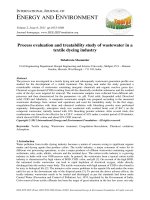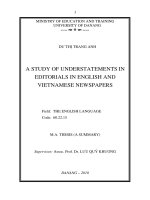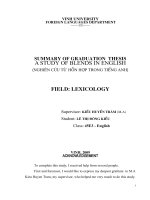Study of phenophasic climatic requirement for maximum yield of rice in the prevailing weather conditions
Bạn đang xem bản rút gọn của tài liệu. Xem và tải ngay bản đầy đủ của tài liệu tại đây (452.84 KB, 8 trang )
Int.J.Curr.Microbiol.App.Sci (2019) 8(4): 2002-2009
International Journal of Current Microbiology and Applied Sciences
ISSN: 2319-7706 Volume 8 Number 04 (2019)
Journal homepage:
Original Research Article
/>
Study of Phenophasic Climatic Requirement for Maximum Yield of Rice in
the Prevailing Weather Conditions
Sandeep Kumar Sharma, S.R. Mishra, A.K. Singh, A.N. Mishra,
Sarvesh Baranwal* and S.K. Shukla
Department of Agricultural Meteorology, Narendra Deva University of Agriculture and
Technology Kumarganj, Faizabad-224 229 (U.P.), India
*Corresponding author
ABSTRACT
Keywords
Growing degree
days, Photothermal
units, Heliothermal
units, Heat use
efficiency
Article Info
Accepted:
15 March 2019
Available Online:
10 April 2019
A field experiment was conducted during kharif season of 2017-18 on the topic entitled
“Effect of growing environment on growth and development of rice (Oryza sativa L.)
cultivars.” in sandy loam soil of N.D. University of Agriculture and Technology,
Kumarganj, Faizabad (U.P.). The experiment consisted of nine treatment combinations
comprised of three transplanting dates viz. July 5th, July 15th and July 25th and three
varieties viz., NDR-97, NDR-3112 and BPT-5204. Results reveal that different
phenophases of rice markedly varied with only dates of transplanting but also different
weather variables which ultimately create the different crop growing environment to
harvest the yield accordingly. Highest Growing Degree days (GDD) was recorded in
growing environment of July 5th due to occurrence of long duration. Highest heliothermal
and photothermal unit was recorded in Ist date of transplanting on July 5th at vegetative
stage.
Introduction
Rice (Oryza sativa L.) is the paramount cereal
crop after wheat belonging to the grass
family, poaceae, extensively cultivated in
most parts of the world and is the major staple
food for more than half of the global
population (FAO, 2013). Rice is a staple food
of more than 50 per cent of the world’s
population (Anonymous, 2011) During 201314 in India, rice is cultivated in an area of 46
million ha with a production of 106.5 million
tonnes and yield 2424 kg ha1(Agricultural
statistics at a glance, 2014). However,
productivity of rice in India is much lower
than that of other rice producing countries.
The impact of air temperature on rice growth
would be location-specific because of the
different sensitivity of different locations with
regard to temperature. In tropical regions, the
temperature increase due to the climate
change is probably near or above the optimum
temperature range for the physiological
activities of rice [Baker et al., 1992]. Such
warming will thus reduce rice growth. Rice
productivity is highly dependent upon
2002
Int.J.Curr.Microbiol.App.Sci (2019) 8(4): 2002-2009
prevailing weather conditions. Some of the
weather parameters like sunshine hours,
rainfall and temperature are important natural
resources which affect the rice productivity to
a greater extent. The optimum utilization of
these resources can also vary among different
rice genotypes. To study the extent and
comparative utilization of these resources
some weather based agro indices had been
developed were growing degree days (GDD),
photothermal units (PTU), heliothermal units
(HTU) and heat use efficiency (HUE). GDD
is the most common temperature index used
to estimate plant development (Qadir et al.,
2006). Therefore, it is better to calculate
efficiency of utilization of heat in terms of dry
matter accumulation depends on crop type,
genetic factors and sowing time and has great
practical application (Rao et al., 1999).
Successful yield estimation by application of
yield components considering seasonal
change in meteorological conditions may be
useful for evaluating the best variety type for
achieving high yield based on rice
morphology under future environmental
conditions, facilitating improvements in the
breeding strategies in the future. Because the
production of new cultivars generally require
at least 10 years for breeders. It is necessary
for breeding strategies to be closely
coordinated with climate change predictions
and to consider several decades.
during its cropping period. The total rainfall
received during the cropping period was
681.4 mm. The day length during the
cropping period ranges from 11.65 hrs –
12.28 hrs and the average bright sun shine
hour was 11.48 hours.
Experimental treatments and procedures
The
experiment
was
conducted
in
Randomized block design with three
replications. The experiment consisted of nine
treatment combination comprised of three
transplanting dates viz. July 5th, July 15th and
July 25th and three varieties viz., NDR-97,
NDR-3112 and BPT-5204 of rice genotypes
having different maturity groups. The details
of experiment has been described elsewhere
Sandeep Kumar Sharma 2016-17. Statistical
analysis and interpretation of results were
done by calculating values of GDD, PTU,
HTU and HUE.
Heat units
The growing degree days (GDD) was
calculated following Nuttonson (1955); taking
base temperature of 10°C.
GDD = (Tmax+Tmin)/2 – Tb
Experimental site
Where,
Tmax = Daily maximum temperature (oC)
Tmin = Daily minimum temperature (oC)
Tb = Base temperature (100C for rice)
The experiment was conducted at N.D.
University of Agriculture and Technology,
Kumarganj, Faizabad U.P. India, during
Kharif season of 2017-18. During cropping
period in the average maximum and the
minimum temperature were 31°C and 22°C,
respectively. The data indicates that the crop
received below normal maximum temperature
and above normal minimum temperature
The heliothermal units (HTU) was calculated
as;
HTU = GDD × Actual bright sunshine hours
(°C day hours)
The photothermal units (PTU) was calculated
as;
PTU = GDD× Day length (°C day hours)
The heat use efficiency (HUE) was calculated
as;
Materials and Methods
2003
Int.J.Curr.Microbiol.App.Sci (2019) 8(4): 2002-2009
Heat use efficiency (kg ha-1°C day-1) =
Grain yield (kg ha-1)
AGDD (°C day)
Where,
AGDD (kg ha-1°C day-1) = Accumulated
growing degree days.
days taken to maturity and followed by NDR3112 had taken 106 days and last NDR-97
variety taken 100 days. So the BPT-5204 and
NDR-97 have significant difference could be
observed in the days taken to attain
physiological maturity. Also observation was
clearly depicted in below given graph (Fig. 1–
3).
Growing degree days (GDD)
Results and Discussion
Crop phenology
Sowing time application had significant effect
on phenology of rice. Data pertaining to days
taken to different phenophases until the
maturity as affected by different growing
environment of rice cultivars have been
presented in Table 1 data showed that
different growing environment influenced rice
cultivars.
Maximum days taken to maturity on the basis
of date of transplanting (DAT) 116 days were
recorded when crop was transplanted on July
5th followed by July 15th and July 25th.The
minimum days taken to maturity was
recorded 104 days on 3rd date of
transplanting. The crop duration decreased
with delay in sowing. On the other hand in
this experiment rice variety BPT-5204 122
Early sown crop (5th July) consumed
significantly higher heat units as compared to
15th July and 25th July sown crop to attain
physiological maturity.
Heliothermal units
Data pertaining to heliothermal unit as
affected by different growing environment of
rice cultivars have been presented in table 2
and clearly depicted in figure 2 and 3. From
table it was revealed that heliothermal unit
was recorded highest in Ist date of
transplanting on July 5th (0days hours)
followed by July 15th and July 25th.
Among the varieties highest heliothermal unit
at vegetative and reproductive stages were
recorded in cultivars BPT-5204 followed by
NDR-97 and NDR-3112.
Table.1 Days taken to different phenophases
Treatments
Growing Environment
5th July
15thJuly
25th July
Varieties
NDR-97
NDR-3112
BPT-5204
Phenophases
Days to panicle Days
initiation
50%Flowering
73
83
70
80
68
77
61
63
75
77
79
91
2004
to Physiological
Maturity
116
111
104
100
106
122
Int.J.Curr.Microbiol.App.Sci (2019) 8(4): 2002-2009
Fig.1
Fig.2
Fig.3
2005
Int.J.Curr.Microbiol.App.Sci (2019) 8(4): 2002-2009
Table.2 Accumulated heliothermal unit as affected by different growing environment of rice
cultivars
Treatments
Growing environment
5th July
15thJuly
25th July
Varieties
NDR-97
NDR-3112
BPT-5204
Phenophases/Stage
Heliothermal unit (0days hrs.)
Vegetative
Reproductive
5369.76
9507.30
4972.44
9045.80
4636.69
8388.67
3651.54
3896.44
5674.81
Fig.4
Fig.5
2006
8957.60
8545.47
9977.37
Int.J.Curr.Microbiol.App.Sci (2019) 8(4): 2002-2009
Table.3 Accumulated photothermal unit as affected by different growing environment of rice
cultivars
Treatments
Growing environment
5th July
15thJuly
25th July
Varieties
NDR-97
NDR-3112
BPT-5204
Phenophases/Stage
Photothermal unit (0days hrs.)
Vegetative
Reproductive
22270.5
28863.9
21435.3
28210.6
20160.0
24417.8
22868.0
21910.2
23741.0
Fig.6
Fig.7
2007
26241.9
25802.9
27593.3
Int.J.Curr.Microbiol.App.Sci (2019) 8(4): 2002-2009
Table.4 Accumulation of Bright sunshine hours as affected by different growing environment of
rice cultivars
Treatments
Growing environment
5th July
15thJuly
25th July
Varieties
NDR-97
NDR-3112
BPT-5204
Phenophases/Stage
Bright sun shine (BSS) (hrs.)
Vegetative
Reproductive
371.2
650.6
326.3
593.1
320.9
546.7
186.5
199.1
285.0
435.2
479.5
583.4
Table.5 Heat use efficiency (HUE) as affected by different growing environment of rice
cultivars
Treatments
Growing
environment
5th July
15thJuly
25th July
Varieties
NDR-97
NDR-3112
BPT-5204
Heat use efficiency (g/m2/0days)
15
DAT
0.381
0.377
0.342
30
DAT
0.334
0.334
0.320
45
DAT
0.325
0.321
0.291
60
DAT
0.346
0.341
0.310
75
DAT
0.422
0.414
0.383
90
DAT
0.479
0.452
0.438
105
DAT
0.481
0.460
0.444
0.377
0.365
0.381
0.330
0.320
0.334
0.292
0.345
0.309
0.311
0.368
0.330
0.378
0.448
0.401
0.431
0.491
0.436
0.391
0.515
0.462
Fig.8
2008
Int.J.Curr.Microbiol.App.Sci (2019) 8(4): 2002-2009
Photothermal unit
Data pertaining to photothermal unit as affected
by different growing environment of rice
cultivars have been presented in table 3 and by
graph 6 and 7. From table it was revealed that
photothermal unit was recorded highest in Ist
date of transplanting on July 5th, at vegetative
and reproductive stages as followed by July 15th
and July 25th. Among the varieties highest
photothermal
unit
at
vegetative
and
reproductive stages was recorded in variety
BPT-5204, followed by NDR-97 and NDR3112.
Bright Sunshine hours
Bright sunshine (hrs.) of rice cultivars at
different growing environment has been
depicted in table 4. From table it was revealed
that highest bright sunshine (hrs.) was recorded
at Ist date of transplanting on (650.6) July 5th
followed by (593.1) July 15th and (546.7) July
25th respectively. Among the varieties bright
sunshine hours were recorded highest in cultivar
BPT-5204 (583.4) followed by NDR3112(479.5) and NDR-97(435.2).
Heat use efficiency
Heat use efficiency (HUE) (g/m2/0days) of rice
cultivars at different growing environment has
been depicted in table 5 and figure 8. From
table it was revealed that maximum Heat use
efficiency HUE (g/m2/0days) (0.481) was
recorded at Ist date of transplanting on July 5th at
105 DAT followed by July 15th (0.460) and July
25th (0.444). Among the varieties, NDR-3112
possess highest Heat use efficiency (0.515) at
105 DAT followed by BPT-5204(0.462) and
NDR-97(0.391).
The study concluded that Highest GDD, HTU
and PTU was recorded in growing environment
of first date of transplanting at all the
phenophases. While among the variety BPT5204 (2275.90days) recoded highest GDD due
to occurrence of long duration. Variety NDR3112 found suitable for higher productivity.
Highest Heat use efficiency (HUE) was
recorded in growing environment of July 5th
(0.481 gm-20days) transplanting at all the stage
followed by July 15th (0.460 gm-20days) and
July 25th (0.444 0days) transplanting while
among the variety NDR-3112 (0.515 gm-20days)
recoded highest HUE followed by BPT5204(0.462gm-20days)and NDR-97 (0.391gm20
days).
References
Anonymous, (2008). Radiation use efficiency
(RUE). Annual Report of All India
Coordinated Research Project on Agrometeorology, pp. 103.
Baker JT, Allen LH, Boote KJ. Temperature
effects on rice at elevated CO2
concentration. J Exp Bot. 1992; 43:959964.
FAO.(2013). Statistical Yearbook 2013.Food and
Agricultural Organization, Rome.
Nuttonson, M. Y.(1955). Wheat climate
relationships and use of phenology in
ascertaining the thermal and Photothermal
requirement of wheat. American Institute of
Crop Ecology, Washington DC, pp 338.
Qadir, G., Ahmed, S., Hassan, F.U. and Cheema,
M. (2006). Oil and fatty acid accumulation
in sunflower as influenced by temperature
variations. Pak. J. Bot. 38: pp. 1137-1147.
Rao, V.U.M., Singh, D and Singh, R. (1999). Heat
use efficiency of winter crop in Haryana. J.
Agrometeorol. 1:143-148.
How to cite this article:
Sandeep Kumar Sharma, S.R. Mishra, A.K. Singh, A.N. Mishra, Sarvesh Baranwal and Shukla, S.K.
2019. Study of Phenophasic Climatic Requirement for Maximum Yield of Rice in the Prevailing
Weather Conditions. Int.J.Curr.Microbiol.App.Sci. 8(04): 2002-2009.
doi: />
2009









